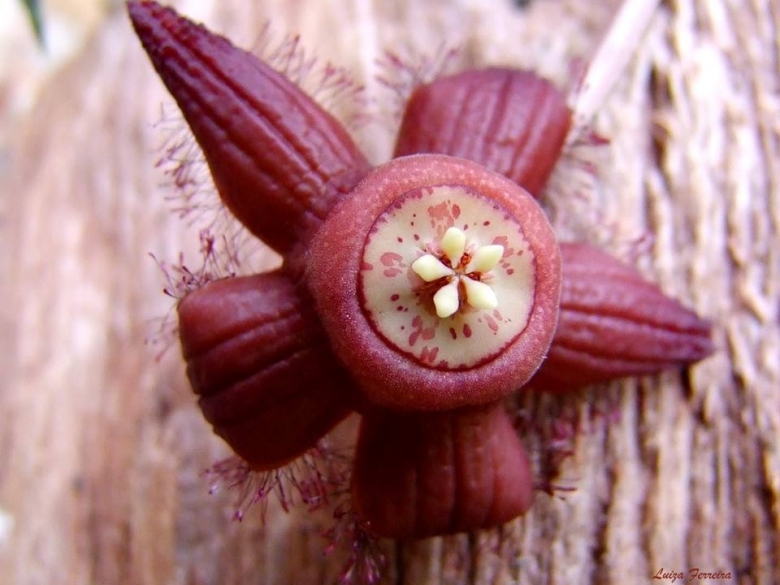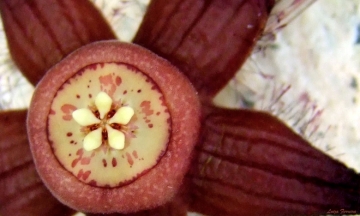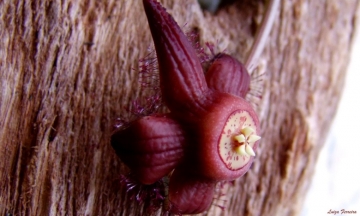
Duvalia sulcata subs. seminuda Photo by: Luiza Ferreira
Origin and Habitat: Duvalia sulcataSN|30343]]SN|30343]] subs. seminuda is fairly abundant over quite a large range in northern Yemen and Saudi Arabia ( from near Ad Aridah, near the Yemen border and along the road to Abu Arish, near Al Hagu, around Muhayl, along the Muhayl--Mudhaylif road as far as Namrah, and along several kilometers of the lower part of the Al Abna Descent)
Type locality: Subaihi Country. Yemen.
Altitude range: This subspecies is mainly found at medium altitudes in the western Asir and the Mountain-Tihama between 250 and 700 metres above sea level.
Habitat and ecology: It grows on well drained stony ground always at the base of acacia trees or in the shade of shrubs. Nonetheless they can tolerate a variety of sandy or gravelly conditions but never in grass tufts, unlike Duvalia sulcataSN|30343]]SN|30343]].
Synonyms:
See all synonyms of Duvalia sulcata
Description: Duvalia sulcata subs. seminuda is a mottled grey-green four-angled succulent with long soft teeth and ascending stems. It can form wide carpets which, at the right moment, can carry many flowers. The star-like flowers have shiny bright brownish-red corolla lobes tipped with either red or white hairs, but unlike the normal Duvalia sulcataSN|30343]]SN|30343]] the annulus is glabrous. Apart from the presence or absence of hairs on the annulus, the colour of Duvalia sulcataSN|30343]]SN|30343]] subs. seminuda is a deep purplish-red with, very occasionally, one or two hairs on the annulus and the lobes are usually thinner; conversely the standard Duvalia sulcataSN|30343]]SN|30343]] is always a flesh-pink with usually larger lobes with a dense crown of long, white hairs on the annulus. The scent of the flowers is foetid, but often almost not perceptible, if any. The flowers are usually 2.5 cm wide.
Stems: Short and plump, club-shaped with a long curved narrow base, 2-6 cm long, 10-22 mm thick, bluntly 4-angled, greyish-green spotted dark green to maroon.
Leaves: Rudimentary approx 5-8 mm long.
Inflorescences: With two or three flowers opening in succession from a single growing point arising from near the centre or base of a stem. The flowers trail along the ground or lean down. Peduncle 1.5-4 cm long. Pedicels short and producing a prolongation of the peduncle along which the flowers are disposed.
Flowers: Long-lasting, scentless or with a foul smell. Sepals 3-6 mm long. Corolla 30-45 mm across, ochre, pale maroon, reddish- or dark brown. Corolla-lobes 10-16 mm long, 7-12 mm wide, lamina slightly convex, and seldom reflexed corolla tips, furrowed, glabrous, apex and basal angles between the lobes finely tuberculate, papillate or tomentose, margins with vibratile clavate hairs. Hairs white or purple, 2-3 mm long. Annulus 9-12 mm in diaeter, 2-4 mm high, massive, glabrous to slightly hairy. Corona cream to pale maroon, partly spotted reddish-brown, disc 6.5-10 mm in diameter, roundish, 5- to 10-angled. Inner-corona lobes some-times white, 2.2-4 mm long, 1.4-2.2 mm wide, outer append-ages obtuse to acuminate. Pollinia 0.35 - 0.5 x 0.25 - 0.3 mm. The buds are a pointed pyramid shape and this immediately distinguishes them from those of the ralated Duvalia velutina when the plants have no open flowers.
Fruits: Flies pollinated, the flowers resulting in the typical twin seed horns (follicles), which are decorative in themselves and often don't appear until a year later.
Subspecies, varieties, forms and cultivars of plants belonging to the Duvalia sulcata group
Duvalia sulcata form a very variable complex. 3 or 4 subspecies can be recognized as geographically and morphologically (to a wide extent) clearly distinct entities.
Bibliography: Major references and further lectures:
1) Focke Albers, Ulrich Meve “Illustrated Handbook of Succulent Plants: Asclepiadaceae: Asclepiadaceae” Volume 4 Springer, 2002
2) Ulrich Meve, Focke Albers “The species concept in Duvalia (Asclepiadaceae): A preliminary revision of the genus” In: Mitteilungen aus dem Institut für Allgemeine Botanik in Hamburg. 23: 595–604.1990.
3) Sheila Collenette “An illustrated guide to the flowers of Saudi Arabia” Scorpion, 1985
4) Werner Rauh “The Wonderful World of Succulents: Cultivation and Description of Selected Succulent Plants Other Than Cacti” Smithsonian Institution Press, 1984
5) Bruyns, P. V. 2005. "Stapeliads of Southern Africa and Madagascar", vol. 1: 68-81.
6) Meve, U. 1997. "The genus Duvalia (Stapelieae)", 130 pp, Springer, Wien.
 Duvalia sulcata subs. seminuda Photo by: Luiza Ferreira
Duvalia sulcata subs. seminuda Photo by: Luiza Ferreira Duvalia sulcata subs. seminuda Photo by: Luiza Ferreira
Duvalia sulcata subs. seminuda Photo by: Luiza Ferreira Duvalia sulcata subs. seminuda Photo by: Luiza Ferreira
Duvalia sulcata subs. seminuda Photo by: Luiza FerreiraSend a photo of this plant.The gallery now contains thousands of pictures, however it is possible to do even more. We are, of course, seeking photos of species not yet shown in the gallery but not only that, we are also looking for better pictures than those already present.
Read More... Cultivation and Propagation: Duvalia sulcata is an easy obliging blooming plant when mature, that it is happy in any average succulent house.
Potting:Since roots are quite shallow, use a soft and incoherent cactus mix or add extra perlite or pumice to regular soil potting soil, and clay pots help the plants to dry out between watering.
Waterings: Duvalia require moderately watering through the growing season but enjoy plenty of water and some fertiliser in hot weather, this helps them to flower freely. Water more sparingly in winter according to temperatures. But, as with most asclepiads, it is unwise to leave them wet in cold weather.
Fertilization: Fertilizers for succulent plants must be rich in potassium, but poor in nitrogen, to avoid the plants from developing excess vegetation, which is easily attacked by fungal diseases.
Sun Exposure: As with many succulents, they prefer to grow in the light shade of scrubby shrubs or between rocks where they get some shade during the day. In summer it is advisable to position this plant in a partially shady place, where it is exposed to direct sunlight only during the coolest hours of the day.
Hardiness: These plants don't like cold weather, therefore in the Spring it is best to set them outside only when the temperatures are above 15°C. Can endure temperatures below 5°C for short period, but only if the soil stays completely dry.
Pest and diseases: Duvalia species vary in their susceptibility to rotting, but are generally fairly easy to grow, especially if kept pest-free. They are very susceptible to stem and root mealy bugs, and damage from these may well initiate fungal attack. If you do have problems with a stem or with basal rotting, you can reliably isolate the healthy parts, dry them off, and re-root them in moist compost.
Cultural Practices: Re-pot every 2 years.
Propagation: Easiest with stem cuttings. Allow cuttings to dry a day before planting. Stems must be laid (Not buried) on gritty compost and will then root from the underside of the stems. It can also be increased from seeds sowing in spring in moist, sandy peat moss. Barely cover seeds. Seeds germinate quickly.














